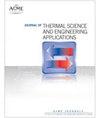Experimental Investigation of Energy-Saving Potential of Ground Source Heat Pump during Peak Hour Operations
IF 1.4
4区 工程技术
Q3 ENGINEERING, MECHANICAL
引用次数: 0
Abstract
Ground source heat pump (GSHP) systems have emerged as energy-efficient alternate systems for conventional the Air-Source Air-Conditioning (ASAC) systems for space heating and cooling applications. GSHPs have gained widespread popularity globally and are extensively utilized in residential and commercial buildings. However, in countries like India where both space cooling and heating are required, it becomes essential to evaluate the performance of GSHP system, especially during peak hour operation to estimate peak load energy demand. This research paper tries to identify the energy efficiency of GSHP system during peak-hour operations in comparison to ASAC system using experimental techniques. Experimental trials were conducted in a laboratory equipped with a single unit of 17.58 kW cooling/heating capacity GSHP system and a 17.57 kW cooling/heating ASAC system (two units of 7.023 kW and 10.548 kW). Experimental trials were conducted in peak summer in the month of June for cooling mode operation and January for heating mode operation for Roorkee weather conditions in northern part of India. The performance of both the systems was compared by defining instantaneous COP and cyclic COP. The instantaneous COP was found to be higher for both the systems during peak hour cooling and heating mode operations. Energy-saving analysis indicates that the ground source heat pump system saves 36.85% and 38.65% of electrical energy in cooling and heating modes, respectively, compared to the ASAC system.地源热泵在高峰时段运行的节能潜力实验研究
地源热泵(GSHP)系统已成为传统空气源空调(ASAC)系统在空间供暖和制冷应用中的节能替代系统。地源热泵在全球范围内受到广泛欢迎,并被广泛应用于住宅和商业建筑中。然而,在印度等既需要空间制冷又需要空间供暖的国家,评估 GSHP 系统的性能变得非常重要,尤其是在高峰时段运行时,以估算高峰负荷的能源需求。本研究论文试图利用实验技术,将高峰时段运行的 GSHP 系统与 ASAC 系统进行比较,以确定其能源效率。实验在一个实验室中进行,该实验室配备了一个单机制冷/制热能力为 17.58 千瓦的 GSHP 系统和一个制冷/制热能力为 17.57 千瓦的 ASAC 系统(两台机组的功率分别为 7.023 千瓦和 10.548 千瓦)。实验分别在印度北部罗尔基(Roorkee)天气条件下的 6 月夏季高峰期和 1 月进行,前者采用制冷模式运行,后者采用制热模式运行。通过定义瞬时 COP 和循环 COP 对两种系统的性能进行了比较。结果发现,在制冷和制热模式运行的高峰时段,两种系统的瞬时 COP 都较高。节能分析表明,与 ASAC 系统相比,地源热泵系统在制冷和制热模式下分别可节省 36.85% 和 38.65% 的电能。
本文章由计算机程序翻译,如有差异,请以英文原文为准。
求助全文
约1分钟内获得全文
求助全文
来源期刊

Journal of Thermal Science and Engineering Applications
THERMODYNAMICSENGINEERING, MECHANICAL -ENGINEERING, MECHANICAL
CiteScore
3.60
自引率
9.50%
发文量
120
期刊介绍:
Applications in: Aerospace systems; Gas turbines; Biotechnology; Defense systems; Electronic and photonic equipment; Energy systems; Manufacturing; Refrigeration and air conditioning; Homeland security systems; Micro- and nanoscale devices; Petrochemical processing; Medical systems; Energy efficiency; Sustainability; Solar systems; Combustion systems
 求助内容:
求助内容: 应助结果提醒方式:
应助结果提醒方式:


